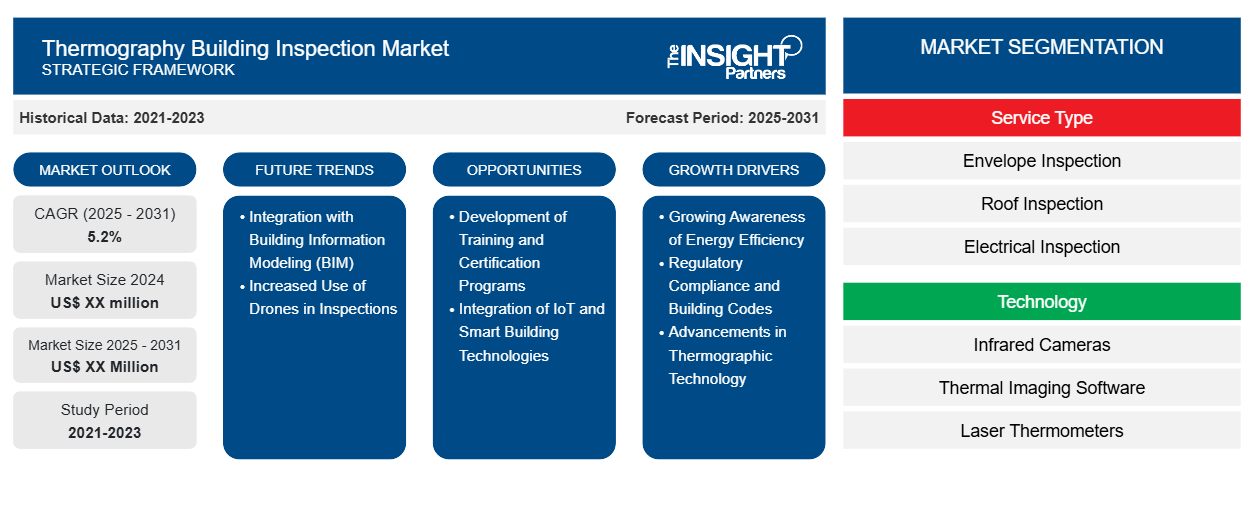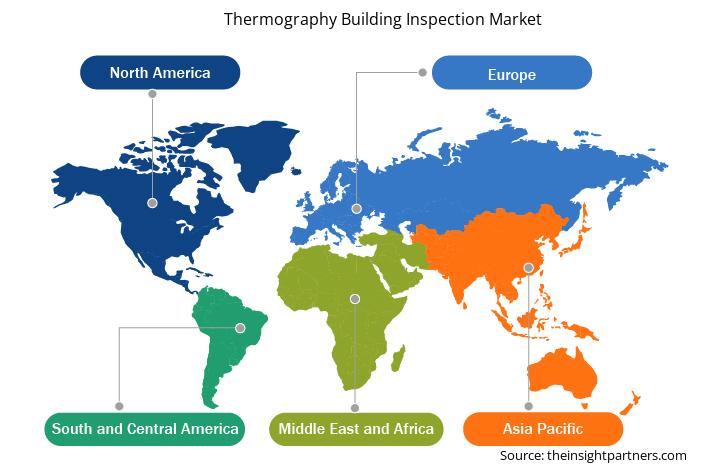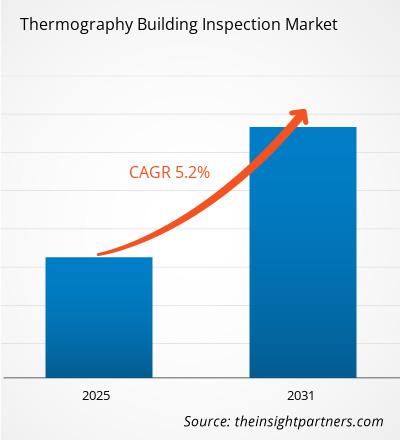预计热成像建筑检查市场在 2025 年至 2031 年期间的复合年增长率为 5.2%,市场规模将从 2024 年的 XX 百万美元扩大到 2031 年的 XX 百万美元。
报告按服务类型(外壳检测、屋顶检测、电气检测、机械检测)、技术(红外热像仪、热成像软件、激光测温仪)、应用(住宅、商业、工业)和地域(北美、欧洲、亚太、中东和非洲、南美和中美)细分。
全球分析进一步细分为区域和主要国家。报告提供上述分析和细分的美元价值。
报告目的
Insight Partners 发布的《热成像建筑检查市场》报告旨在描述当前形势和未来增长、主要驱动因素、挑战和机遇。这将为各业务利益相关者提供见解,例如:
- 技术提供商/制造商:了解不断变化的市场动态并了解潜在的增长机会,使他们能够做出明智的战略决策。
- 投资者:对市场增长率、市场财务预测以及整个价值链中存在的机会进行全面的趋势分析。
- 监管机构:规范市场政策和警察活动,旨在最大限度地减少滥用行为,维护投资者的信任和信心,维护市场的完整性和稳定性。
热成像建筑检查市场细分
服务类型
- 信封检查
- 屋顶检查
- 电气检查
- 机械检查
技术
- 红外摄像机
- 热成像软件
- 激光温度计
应用
- 住宅
- 商业的
- 工业的
地理
- 北美
- 欧洲
- 亚太地区
- 中东和非洲
- 南美洲和中美洲
定制此报告以满足您的要求
您可以免费定制任何报告,包括本报告的部分内容、国家级分析、Excel 数据包,以及为初创企业和大学提供优惠和折扣
热成像建筑检查市场:战略洞察

- 获取此报告的顶级关键市场趋势。此免费样品将包括数据分析,从市场趋势到估计和预测。
热成像建筑检查市场的增长动力
- 能源效率意识的不断增强:建筑节能意识的日益增强是热成像建筑检测市场的重要驱动力。热成像检测有助于识别建筑围护结构中的热异常,例如绝缘缺陷、漏气和湿气侵入。随着企业和业主寻求降低能源消耗和降低公用事业成本,对用于评估和改善能源性能的热成像检测的需求日益增长。这种意识正在推动更多利益相关者投资热成像技术,将其作为提高能源效率的主动措施。
- 法规合规性和建筑规范:政府和监管机构正在实施更严格的建筑规范和标准,旨在提高能源效率和可持续性。遵守这些法规通常需要进行建筑检查,包括热成像评估。随着建筑业主和承包商努力满足这些标准,对可靠的热成像服务的需求也日益增长。这种监管压力促使人们将热成像检查作为常规建筑评估的一部分,以确保合规性并避免处罚。
- 热成像技术的进步:热成像设备和软件的技术进步正在提升建筑检查的能力和准确性。现代热成像摄像机拥有更高的分辨率、更高的灵敏度和先进的分析功能,使检查人员能够检测到哪怕是最细微的温度变化。此外,集成数据分析和报告功能的软件解决方案使专业人员能够更轻松地解读热图像并将结果呈现给客户。这些进步通过提高检查的效率和效果,推动了热成像建筑检查市场的增长。
热成像建筑检查市场未来趋势
- 与建筑信息模型 (BIM) 集成:热成像技术与建筑信息模型 (BIM) 的集成正成为建筑检测市场的一大趋势。BIM 能够创建物理结构的详细数字表示,并与热成像数据结合,提供全面的建筑性能视图。这种集成使建筑业主和管理者能够在整个建筑环境中直观地了解热问题,从而促进更明智的决策和有针对性的补救措施。
- 无人机在检查中的应用日益广泛:无人机技术在热成像检查中的应用正在兴起。配备热成像摄像机的无人机无需脚手架或梯子,即可进入屋顶和外墙等难以触及的区域。这一趋势不仅增强了安全性,还通过更快地在大面积区域收集数据来提高检查效率。无人机的使用正在彻底改变热成像检查的开展方式,使其更易于操作且更具成本效益。
热成像建筑检查市场机遇
- 培训和认证项目的开发:随着热成像检测需求的增长,培训和认证项目有机会确保专业人员能够熟练使用热成像设备和解读结果。开发经认证的培训项目可以提升热成像服务提供商的信誉,并提高检测的整体质量。这一机会也有助于满足行业日益增长的监管和合规要求。
- 物联网与智能建筑技术的融合:物联网 (IoT) 设备与智能建筑技术与热成像技术的融合,为增强建筑性能监测提供了重要机遇。物联网传感器可以提供温度、湿度和能耗的实时数据,这些数据可以与热成像数据关联,从而更深入地洞察建筑性能。这种技术融合可以带来更有效的能源管理策略,并提高建筑运营效率。
热成像建筑检查市场区域洞察
Insight Partners 的分析师已详尽阐述了预测期内影响热成像建筑检查市场的区域趋势和因素。本节还讨论了北美、欧洲、亚太地区、中东和非洲以及南美和中美洲的热成像建筑检查市场细分和地域分布。

- 获取热成像建筑检查市场的区域特定数据
热成像建筑检查市场报告范围
| 报告属性 | 细节 |
|---|---|
| 2024年的市场规模 | XX百万美元 |
| 2031年的市场规模 | XX百万美元 |
| 全球复合年增长率(2025-2031) | 5.2% |
| 史料 | 2021-2023 |
| 预测期 | 2025-2031 |
| 涵盖的领域 | 按服务类型
|
| 覆盖地区和国家 | 北美
|
| 市场领导者和主要公司简介 |
|
热成像建筑检查市场参与者密度:了解其对业务动态的影响
热成像建筑检查市场正在快速增长,这得益于终端用户需求的不断增长,而这些需求的驱动因素包括消费者偏好的不断变化、技术进步以及对产品优势的认知度不断提高。随着需求的增长,企业正在扩展产品线,不断创新以满足消费者需求,并抓住新兴趋势,从而进一步推动市场增长。
市场参与者密度是指特定市场或行业内企业或公司的分布情况。它表明特定市场空间内竞争对手(市场参与者)的数量相对于其规模或总市值而言。
在热成像建筑检查市场运营的主要公司有:
- 白金工具
- Apex仪器
- A. 交通
- 霍尼韦尔
- 雷泰
- 巴尔科维奇企业
免责声明:以上列出的公司没有按照任何特定顺序排列。

- 获取热成像建筑检查市场主要参与者概览
主要卖点
- 全面覆盖:该报告全面涵盖了热成像建筑检查市场的产品、服务、类型和最终用户的分析,提供了整体概况。
- 专家分析:本报告基于对行业专家和分析师的深入了解而编写。
- 最新信息:该报告涵盖了最新信息和数据趋势,确保了业务相关性。
- 定制选项:此报告可以定制以满足特定客户要求并适合业务策略。
因此,这份关于热成像建筑检查市场的研究报告,有助于引领解读行业现状和增长前景的探索。尽管存在一些合理的担忧,但本报告的总体优势往往大于劣势。
- 历史分析(2 年)、基准年、预测(7 年)及复合年增长率
- PEST和SWOT分析
- 市场规模、价值/数量 - 全球、区域、国家
- 行业和竞争格局
- Excel 数据集
近期报告
客户评价
购买理由
- 明智的决策
- 了解市场动态
- 竞争分析
- 客户洞察
- 市场预测
- 风险规避
- 战略规划
- 投资论证
- 识别新兴市场
- 优化营销策略
- 提升运营效率
- 顺应监管趋势




















 获取免费样品 - 热成像建筑检查市场
获取免费样品 - 热成像建筑检查市场